Determining Sources of Air Pollution Exposure Inequity in New York City Through Land-Use Regression Modeling of PM2.5 Constituents †
Abstract
1. Introduction
2. Methods
2.1. New York City Community Air Survey Data
2.2. Spatial Interpolation of Citywide Air Pollution
2.3. Equity Analysis
3. Results and Discussion
3.1. Temporal Trends in Citywide Air Pollution
3.2. Spatial Disparities in NO2 and Total PM2.5 Exposure
3.3. Source-Specific Exposure Trends
3.3.1. Traffic
3.3.2. Residual Oil Boilers
3.3.3. Marine Residual Oil
3.4. Policy Implications
3.5. Strengths and Limitations
4. Conclusions
Supplementary Materials
Author Contributions
Funding
Data Availability Statement
Acknowledgments
Conflicts of Interest
References
- World Health Organization (WHO). Ambient (Outdoor) Air Pollution. 2024. Available online: https://www.who.int/news-room/fact-sheets/detail/ambient-(outdoor)-air-quality-and-health (accessed on 5 November 2024).
- US Environmental Protection Agency (USEPA). Our Nation’s Air: Trends Through 2021. 2022. Available online: https://gispub.epa.gov/air/trendsreport/2022/#home (accessed on 17 May 2023).
- Demetillo, M.A.G.; Harkins, C.; McDonald, B.C.; Chodrow, P.S.; Sun, K.; Pusede, S.E. Space-Based Observational Constraints on NO2 Air Pollution Inequality From Diesel Traffic in Major US Cities. Geophys. Res. Lett. 2021, 48, e2021GL094333. [Google Scholar] [CrossRef]
- Ferguson, L.; Taylor, J.; Davies, M.; Shrubsole, C.; Symonds, P.; Dimitroulopoulou, S. Exposure to indoor air pollution across socio-economic groups in high-income countries: A scoping review of the literature and a modelling methodology. Environ. Int. 2020, 143, 105748. [Google Scholar] [CrossRef]
- Lane, H.M.; Morello-Frosch, R.; Marshall, J.D.; Apte, J.S. Historical Redlining Is Associated with Present-Day Air Pollution Disparities in U.S. Cities. Environ. Sci. Technol. Lett. 2022, 9, 345–350. [Google Scholar] [CrossRef]
- NYC Department of Health and Mental Hygiene (NYCDOHMH). Childhood Asthma and the Asthma Counselor Program of the East Harlem Asthma Center of Excellence. 2017. Available online: https://www.nyc.gov/assets/doh/downloads/pdf/epi/databrief90.pdf (accessed on 7 June 2022).
- Tessum, C.W.; Paolella, D.A.; Chambliss, S.E.; Apte, J.S.; Hill, J.D.; Marshall, J.D. PM2. 5 polluters disproportionately and systemically affect people of color in the United States. Sci. Adv. 2021, 7, eabf4491. [Google Scholar] [CrossRef] [PubMed]
- NYC Department of Health and Mental Hygiene (NYCDOHMH). Health, Housing, and History. 2021. Available online: https://a816-dohbesp.nyc.gov/IndicatorPublic/data-stories/housing/ (accessed on 17 May 2023).
- Nelson, R.K.; Winling, L.; Marciano, R.; Connolly, N. Mapping Inequality; Nelson, R.K., Ayers, E.L., Eds.; American Panorama; Digital Scholarship Lab, University of Richmond: Richmond, VA, USA, 2023; Available online: https://dsl.richmond.edu/panorama/redlining (accessed on 9 June 2022).
- NYC Department of Health and Mental Hygiene (NYCDOHMH). Health Impacts of Air Pollution. 2022. Available online: https://a816-dohbesp.nyc.gov/IndicatorPublic/data-explorer/health-impacts-of-air-pollution/?id=2117#display=summary (accessed on 17 May 2023).
- New York State Department of Health (NYSDOH). Asthma Study—A Response to Budget Article VII, 2018–2019 SFY. 2023. Available online: https://www.health.ny.gov/statistics/ny_asthma/pdf/2018-2019_asthma_burden_nyc.pdf (accessed on 2 January 2025).
- Khan, S.; Bajwa, S.; Brahmbhatt, D.; Lovinsky-Desir, S.; Sheffield, P.E.; Stingone, J.A.; Li, S. Multi-level socioenvironmental contributors to childhood asthma in New York City: A cluster analysis. J. Urban Health 2021, 98, 700–710. [Google Scholar] [CrossRef] [PubMed]
- NYC Department of Health and Mental Hygiene (NYCDOHMH). Health Impacts of Air Pollution. 2022. Available online: https://a816-dohbesp.nyc.gov/IndicatorPublic/data-explorer/health-impacts-of-air-pollution/?id=2108#display=links (accessed on 17 May 2023).
- Bowser, B.P.; Devadutt, C. (Eds.) Racial Inequality in New York City Since 1965; SUNY Press: Albany, NY, USA, 2019. [Google Scholar]
- Office of the New York City Comptroller (NYC Comptroller). The Racial Wealth Gap in New York. 2023. Available online: https://comptroller.nyc.gov/reports/the-racial-wealth-gap-in-new-york/ (accessed on 11 January 2024).
- Poverty Tracker Research Group at Columbia University (Poverty Tracker). The State of Poverty and Disadvantage in New York City. 2021. Volume 3. Available online: https://static1.squarespace.com/static/610831a16c95260dbd68934a/t/6113f3b27a11e63e811521a9/1628697527573/POVERTY_TRACKER_REPORT25.pdf (accessed on 11 January 2024).
- Kheirbek, I.; Wheeler, K.; Walters, S.; Kass, D.; Matte, T. PM2.5 and ozone health impacts and disparities in New York City: Sensitivity to spatial and temporal resolution. Air Qual. Atmos. Health 2013, 6, 473–486. [Google Scholar] [CrossRef] [PubMed]
- Pitiranggon, M.; Johnson, S.; Huskey, C.; Eisl, H.; Ito, K. Effects of the COVID-19 shutdown on spatial and temporal patterns of air pollution in New York City. Environ. Adv. 2022, 7, 100171. [Google Scholar] [CrossRef]
- Strickland, M.J.; Darrow, L.A.; Klein, M.; Flanders, W.D.; Sarnat, J.A.; Waller, L.A.; Sarnat, S.E.; Mulholland, J.A.; Tolbert, P.E. Short-term associations between ambient air pollutants and pediatric asthma emergency department visits. Am. J. Respir. Crit. Care Med. 2010, 182, 307–316. [Google Scholar] [CrossRef] [PubMed]
- US Environmental Protection Agency (USEPA). Integrated Science Assessment for Oxides of Nitrogen—Health Criteria. 2016. Available online: https://assessments.epa.gov/isa/document/&deid=310879 (accessed on 14 May 2021).
- US Environmental Protection Agency (USEPA). Integrated Science Assessment for Particulate Matter. 2019. Available online: https://www.epa.gov/isa/integrated-science-assessment-isa-particulate-matter (accessed on 14 May 2021).
- Taquechel, K.; Diwadkar, A.R.; Sayed, S.; Dudley, J.W.; Grundmeier, R.W.; Kenyon, C.C.; Henrickson, S.E.; Himes, B.E.; Hill, D.A. Pediatric asthma health care utilization, viral testing, and air pollution changes during the COVID-19 pandemic. J. Allergy Clin. Immunol. Pract. 2020, 8, 3378–3387. [Google Scholar] [CrossRef] [PubMed]
- Xu, S.; Glenn, S.; Sy, L.; Qian, L.; Hong, V.; Ryan, D.S.; Jacobsen, S. Impact of the COVID-19 pandemic on health care utilization in a large integrated health care system: Retrospective cohort study. J. Med. Internet Res. 2021, 23, e26558. [Google Scholar] [CrossRef] [PubMed]
- Hennigan, C.J.; Mucci, A.; Reed, B.E. Trends in PM2.5 transition metals in urban areas across the United States. Environ. Res. Lett. 2019, 14, 104006. [Google Scholar] [CrossRef]
- Ito, K.; Johnson, S.; Kheirbek, I.; Clougherty, J.; Pezeshki, G.; Ross, Z.; Eisl, H.; Matte, T.D. Intraurban Variation of Fine Particle Elemental Concentrations in New York City. Environ. Sci. Technol. 2016, 50, 7517–7526. [Google Scholar] [CrossRef]
- FREIGHTOS. Beating Peak Shipping Season. 2023. Available online: https://www.freightos.com/freight-resources/beating-peak-season-blues-shipping-freights-busiest-season/ (accessed on 8 May 2023).
- NYC Economic Development Corporation (NYC EDC). NYCRUISE. 2023. Available online: https://nycruise.com/ (accessed on 8 May 2023).
- Zhu, Q.; Liu, Y.; Hasheminassab, S. Long-term source apportionment of PM2. 5 across the contiguous United States (2000–2019) using a multilinear engine model. J. Hazard. Mater. 2024, 472, 134550. [Google Scholar] [CrossRef]
- Hopke, P.K.; Chen, Y.; Chalupa, D.C.; Rich, D.Q. Long term trends in source apportioned particle number concentrations in Rochester NY. Environ. Pollut. 2024, 347, 123708. [Google Scholar] [CrossRef]
- Squizzato, S.; Masiol, M.; Rich, D.Q.; Hopke, P.K. A long-term source apportionment of PM2.5 in New York State during 2005–2016. Atmos. Environ. 2018, 192, 35–47. [Google Scholar] [CrossRef]
- National Aeronautics and Space Administration (NASA). MAIA: New NASA Instrument to Study Air Pollution. 2023. Available online: https://maia.jpl.nasa.gov/ (accessed on 17 May 2023).
- Matte, T.D.; Ross, Z.; Kheirbek, I.; Eisl, H.; Johnson, S.; Gorczynski, J.E.; Kass, D.; Markowitz, S.; Pezeshki, G.; Clougherty, J.E. Monitoring intraurban spatial patterns of multiple combustion air pollutants in New York City: Design and implementation. J. Expo. Sci. Environ. Epidemiol. 2013, 23, 223–231. [Google Scholar] [CrossRef]
- NYC Department of Health and Mental Hygiene (NYCDOHMH). Appendix 1—Sampling Methodology and Data Sources for Emissions Indicators. 2021. Available online: https://nyccas.cityofnewyork.us/nyccas2021/web/sites/default/files/NYCCAS-appendix/Appendix1.pdf (accessed on 17 May 2023).
- Clougherty, J.E.; Kheirbek, I.; Eisl, H.M.; Ross, Z.; Pezeshki, G.; Gorczynski, J.E.; Johnson, S.; Markowitz, S.; Kass, D.; Matte, T. Intra-urban spatial variability in wintertime street-level concentrations of multiple combustion-related air pollutants: The New York City Community Air Survey (NYCCAS). J. Expo. Sci. Environ. Epidemiol. 2013, 23, 232–240. [Google Scholar] [CrossRef] [PubMed]
- Wood, S.N. Fast stable restricted maximum likelihood and marginal likelihood estimation of semiparametric generalized linear models. J. R. Stat. Soc. Ser. B 2011, 73, 3–36. [Google Scholar] [CrossRef]
- R Core Team. R: A Language and Environment for Statistical Computing; R Foundation for Statistical Computing: Vienna, Austria, 2023; Available online: https://www.R-project.org/ (accessed on 17 March 2022).
- US Environmental Protection Agency (USEPA). Evaluation of CMAQ Applications at Neighborhood Scales. 2024. Available online: https://www.epa.gov/cmaq/evaluation-cmaq-applications-neighborhood-scales (accessed on 2 January 2025).
- Manson, S.; Schroeder, J.; Van Riper, D.; Kugler, T.; Ruggles, S. IPUMS National Historical Geographic Information System: Version 17.0 [Dataset]; IPUMS: Minneapolis, MN, USA, 2022. [Google Scholar] [CrossRef]
- US Census Bureau (US Census). “S0101 Age and Sex”. 2017–2021 American Community Survey. U.S. Census Bureau’s American Community Survey Office. 2021. Available online: https://data.census.gov/table?q=S0101%20Age%20and%20Sex&g=050XX00US36005,36047,36061,36081,36085 (accessed on 12 April 2023).
- Pitiranggon, M.; Johnson, S.; Haney, J.; Eisl, H.; Ito, K. Long-term trends in local and transported PM2.5 pollution in New York City. Atmos. Environ. 2021, 248, 118238. [Google Scholar] [CrossRef]
- de Valpine, P.; Turek, D.; Paciorek, C.J.; Anderson-Bergman, C.; Temple Lang, D.; Bodik, R. Programming with models: Writing statistical algorithms for general model structures with NIMBLE. J. Comput. Graph. Stat. 2017, 26, 403–413. [Google Scholar] [CrossRef]
- Fairburn, J.; Schüle, S.A.; Dreger, S.; Karla Hilz, L.; Bolte, G. Social inequalities in exposure to ambient air pollution: A systematic review in the WHO European region. Int. J. Environ. Res. Public Health 2019, 16, 3127. [Google Scholar] [CrossRef]
- Fan, X.P.; Lam, K.C.; Yu, Q. Differential exposure of the urban population to vehicular air pollution in Hong Kong. Sci. Total Environ. 2012, 426, 211–219. [Google Scholar] [CrossRef] [PubMed]
- Hajat, A.; Hsia, C.; O’Neill, M.S. Socioeconomic disparities and air pollution exposure: A global review. Curr. Environ. Health Rep. 2015, 2, 440–450. [Google Scholar] [CrossRef] [PubMed]
- Pearce, J.; Kingham, S. Environmental inequalities in New Zealand: A national study of air pollution and environmental justice. Geoforum 2008, 39, 980–993. [Google Scholar] [CrossRef]
- Rooney, M.S.; Arku, R.E.; Dionisio, K.L.; Paciorek, C.; Friedman, A.B.; Carmichael, H.; Zhou, Z.; Hughes, A.F.; Vallarino, J.; Agyei-Mensah, S.; et al. Spatial and temporal patterns of particulate matter sources and pollution in four communities in Accra, Ghana. Sci Total Environ. 2012, 435, 107–114. [Google Scholar] [CrossRef] [PubMed]
- Yu, W.; Ye, T.; Chen, Z.; Xu, R.; Song, J.; Li, S.; Guo, Y. Global analysis reveals region-specific air pollution exposure inequalities. One Earth 2024, 7, 2063–2071. [Google Scholar] [CrossRef]
- Samoli, E.; Stergiopoulou, A.; Santana, P.; Rodopoulou, S.; Mitsakou, C.; Dimitroulopoulou, C.; Bauwelinck, M.; de Hoogh, K.; Costa, C.; Marí-Dell’Olmo, M.; et al. Spatial variability in air pollution exposure in relation to socioeconomic indicators in nine European metropolitan areas: A study on environmental inequality. Environ. Pollut. 2019, 249, 345–353. [Google Scholar] [CrossRef]
- Harrison, R.M.; Jones, A.M.; Gietl, J.; Yin, J.; Green, D.C. Estimation of the contributions of brake dust, tire wear, and resuspension to nonexhaust traffic particles derived from atmospheric measurements. Environ. Sci. Technol. 2012, 46, 6523–6529. [Google Scholar] [CrossRef] [PubMed]
- Cornell, A.G.; Chillrud, S.N.; Mellins, R.B.; Acosta, L.M.; Miller, R.L.; Quinn, J.W.; Yan, B.; Divjan, A.; Olmedo, O.E.; Lopez-Pintado, S.; et al. Domestic airborne black carbon and exhaled nitric oxide in children in NYC. J. Expo. Sci. Environ. Epidemiol. 2012, 22, 258–266. [Google Scholar] [CrossRef]
- Rattigan, O.V.; Civerolo, K.; Doraiswamy, P.; Felton, H.D.; Hopke, P.K. Long Term Black Carbon Measurements at Two Urban Locations in New York. Aerosol Air Qual. Res. 2013, 13, 1181–1196. [Google Scholar] [CrossRef]
- R2Logistics. The Ins and Outs of the Seasonality of Freight. 2022. Available online: https://www.r2logistics.com/the-ins-and-outs-of-the-seasonality-of-freight/ (accessed on 8 May 2023).
- Kheirbek, I.; Haney, J.; Douglas, S.; Ito, K.; Caputo, S., Jr.; Matte, T. The public health benefits of reducing fine particulate matter through conversion to cleaner heating fuels in New York City. Environ. Sci. Technol. 2014, 48, 13573–13582. [Google Scholar] [CrossRef] [PubMed]
- Huffman, G.P.; Huggins, F.E.; Shah, N.; Huggins, R.; Linak, W.P.; Miller, C.A.; Pugmire, R.J.; Meuzelaar, H.L.; Seehra, M.S.; Manivannan, A. Characterization of fine particulate matter produced by combustion of residual fuel oil. J. Air Waste Manag. Assoc. 2000, 50, 1106–1114. [Google Scholar] [CrossRef] [PubMed]
- Zhang, L.; He, M.Z.; Gibson, E.A.; Perera, F.; Lovasi, G.S.; Clougherty, J.E.; Carrion, D.; Burke, K.; Fry, D.; Kioumourtzoglou, M.A. Evaluating the Impact of the Clean Heat Program on Air Pollution Levels in New York City. Environ. Health Perspect. 2021, 129, 127701. [Google Scholar] [CrossRef]
- US Environmental Protection Agency (USEPA). International Standards to Reduce Emissions from Marine Diesel Engines and Their Fuels. 2019b. Available online: https://www.epa.gov/regulations-emissions-vehicles-and-engines/international-standards-reduce-emissions-marine-diesel (accessed on 17 May 2023).
- Winebrake, J.J.; Corbett, J.; Green, E.; Lauer, A.; Eyring, V. Mitigating the health impacts of pollution from oceangoing shipping: An assessment of low-sulfur fuel mandates. Environ. Sci. Technol. 2009, 43, 4776–4782. [Google Scholar] [CrossRef]
- Bi, J.; D’Souza, R.R.; Moss, S.; Senthilkumar, N.; Russell, A.G.; Scovronick, N.C.; Chang, H.H.; Ebelt, S. Acute effects of ambient air pollution on asthma emergency department visits in ten US States. Environ. Health Perspect. 2023, 131, 047003. [Google Scholar] [CrossRef] [PubMed]
- NYC Department of City Planning (NYCDCP). New York City’s Current Population Estimates and Trends. 2023. Available online: https://www.nyc.gov/assets/planning/download/pdf/planning-level/nyc-population/population-estimates/population-trends-2022.pdf?r=a (accessed on 12 January 2024).
- NYU Furman Center. State of New York City’s Housing and Neighborhoods in 2015. 2016. Available online: https://furmancenter.org/research/sonychan/2015-report (accessed on 10 January 2023).
- Shaw, N.; Eschenbrenner, B.; Baier, D. Online shopping continuance after COVID-19: A comparison of Canada, Germany and the United States. J. Retail. Consum. Serv. 2022, 69, 103100. [Google Scholar] [CrossRef]
- Zipkin, A. As Online Buying Surges, So Do Noisy Cargo Flights. 2020. Available online: https://www.nytimes.com/2020/04/15/business/cargo-planes-deliveries-noise.html (accessed on 2 January 2025).
- Environmental Defense Fund (EDF). Warehouse Boom Places Unequal Health Burden on New York Communities. 2024. Available online: https://globalcleanair.org/wp-content/blogs.dir/95/files/EDF-NY1.pdf (accessed on 2 January 2025).
- Johnson, S.; Haney, J.; Cairone, L.; Huskey, C.; Kheirbek, I. Assessing Air Quality and Public Health Benefits of New York City’s Climate Action Plans. Environ. Sci. Technol. 2020, 54, 9804–9813. [Google Scholar] [CrossRef] [PubMed]
- New York State. Scoping Plan. 2022. Available online: https://climate.ny.gov/resources/scoping-plan/ (accessed on 6 March 2024).
- US Department of Transportation (USDOT). Biden-Harris Administration Announces Approval of First 35 State Plans to Build Out EV Charging Infrastructure Across 53,000 Miles of Highways. 2022. Available online: https://highways.dot.gov/newsroom/biden-harris-administration-announces-approval-first-35-state-plans-build-out-ev-charging (accessed on 17 May 2023).
- City of New York. PlaNYC: Getting Sustainability Done. 2023. Available online: https://climate.cityofnewyork.us/wp-content/uploads/2023/06/PlaNYC-2023-Full-Report.pdf (accessed on 17 May 2023).
- Kerr, G.H.; Goldberg, D.L.; Harris, M.H.; Henderson, B.H.; Hystad, P.; Roy, A.; Anenberg, S.C. Ethnoracial disparities in nitrogen dioxide pollution in the United States: Comparing data sets from satellites, models, and monitors. Environ. Sci. Technol. 2023, 57, 19532–19544. [Google Scholar] [CrossRef] [PubMed]
- Holgate, S.T.; Wenzel, S.; Postma, D.S.; Weiss, S.T.; Renz, H.; Sly, P.D. Asthma. Nat. Reviews. Dis. Primers 2015, 1, 15025. [Google Scholar] [CrossRef] [PubMed]
- Toskala, E.; Kennedy, D.W. Asthma Risk Factors. Int. Forum Allergy Rhinol. 2015, 5, S11–S16. [Google Scholar] [CrossRef]
- NASA. TEMPO (Tropospheric Emissions: Monitoring of Pollution). 2015. Available online: https://tempo.si.edu/ (accessed on 17 May 2023).
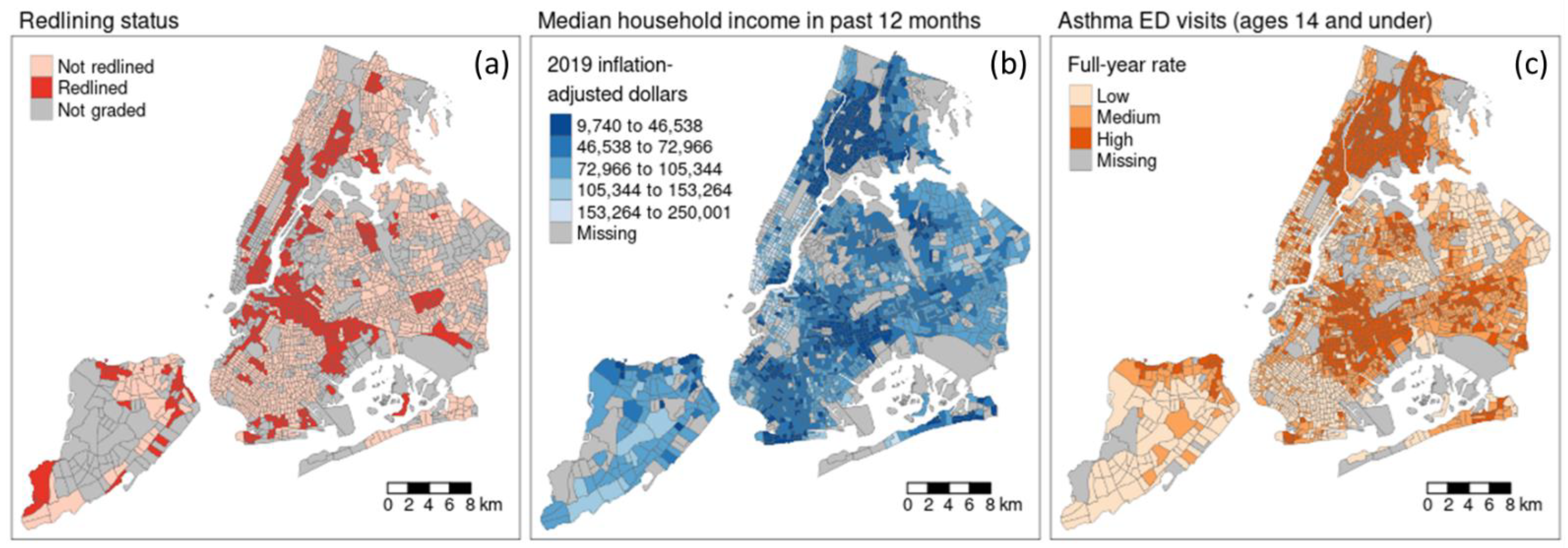
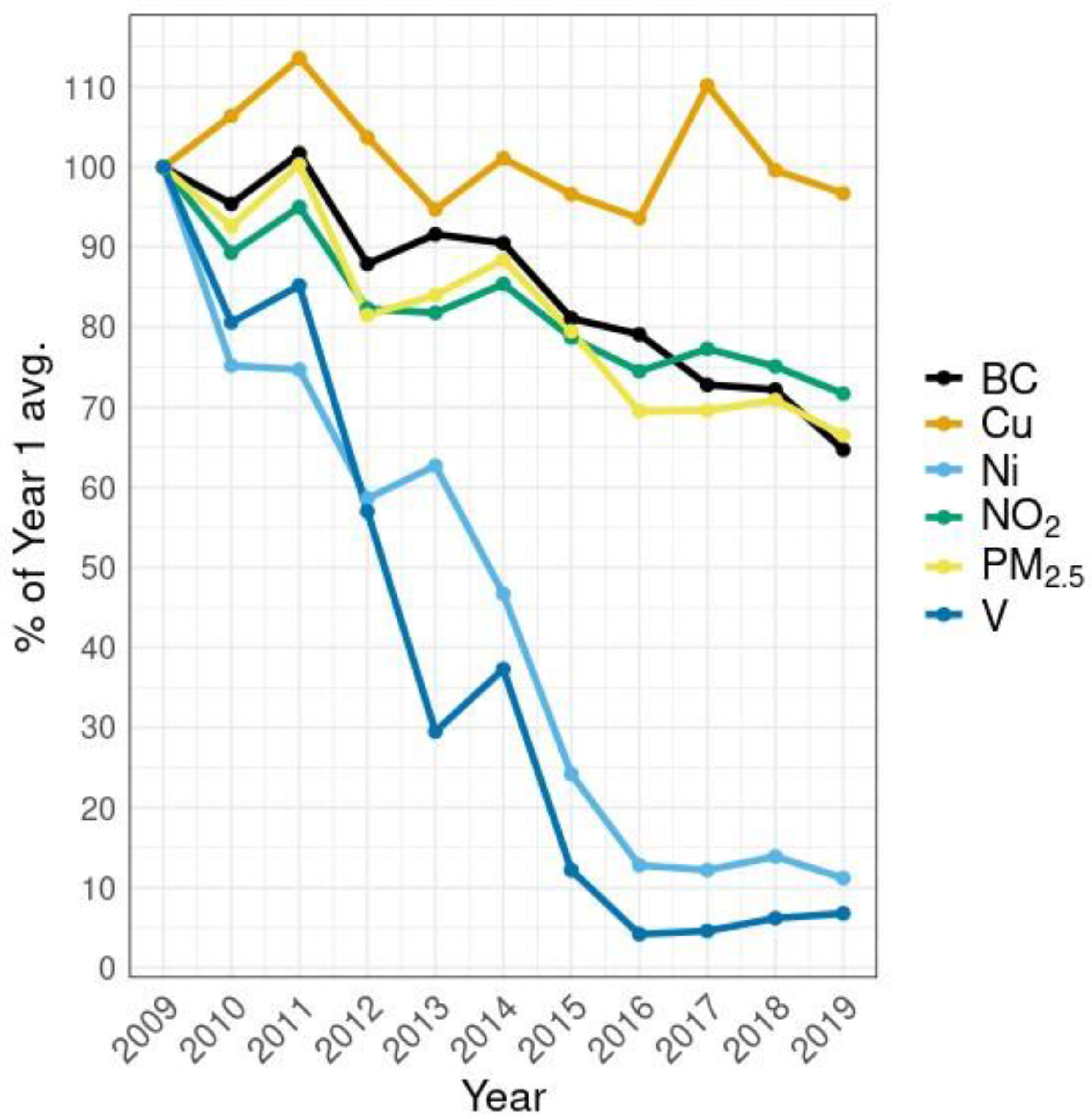
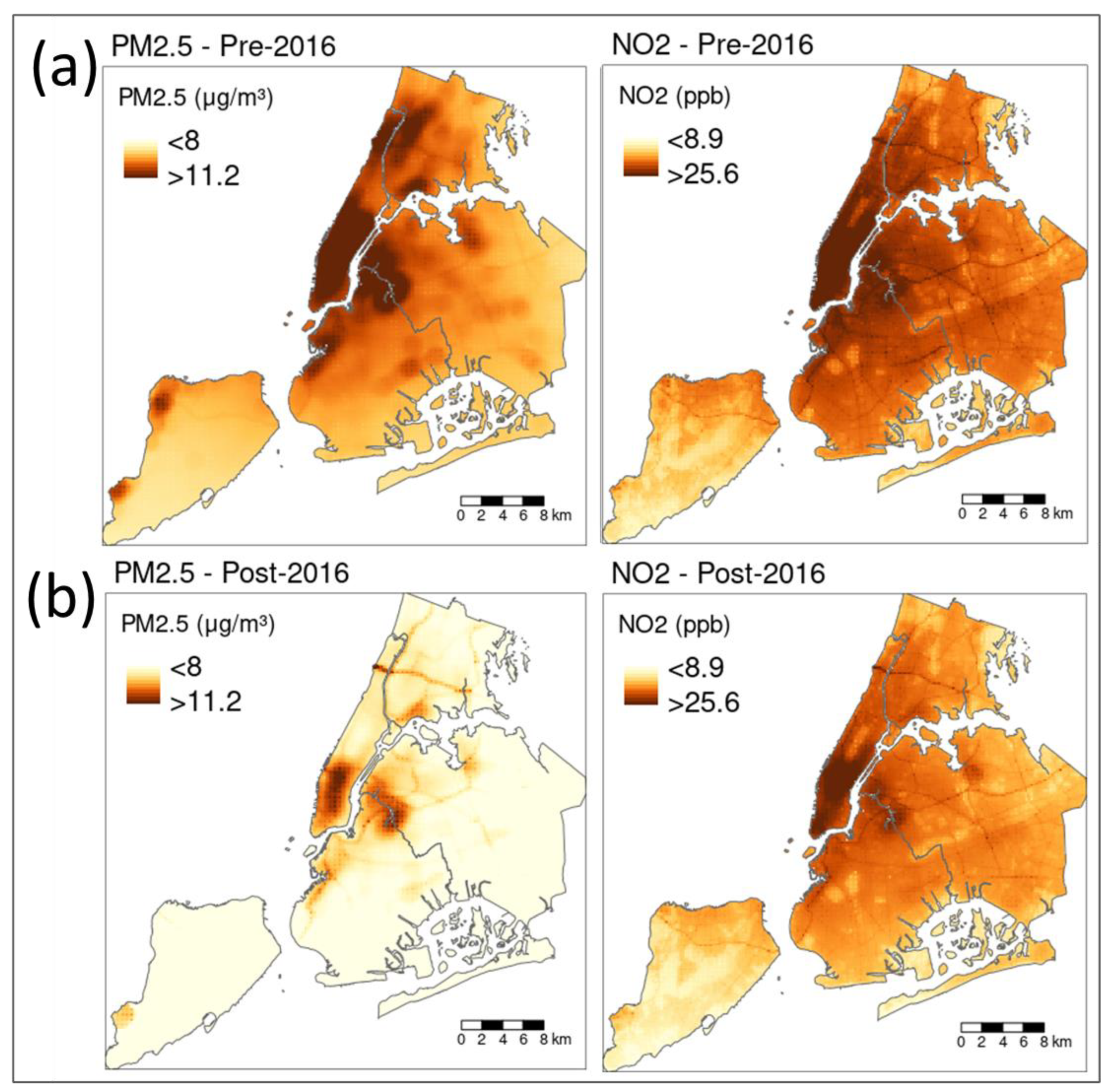
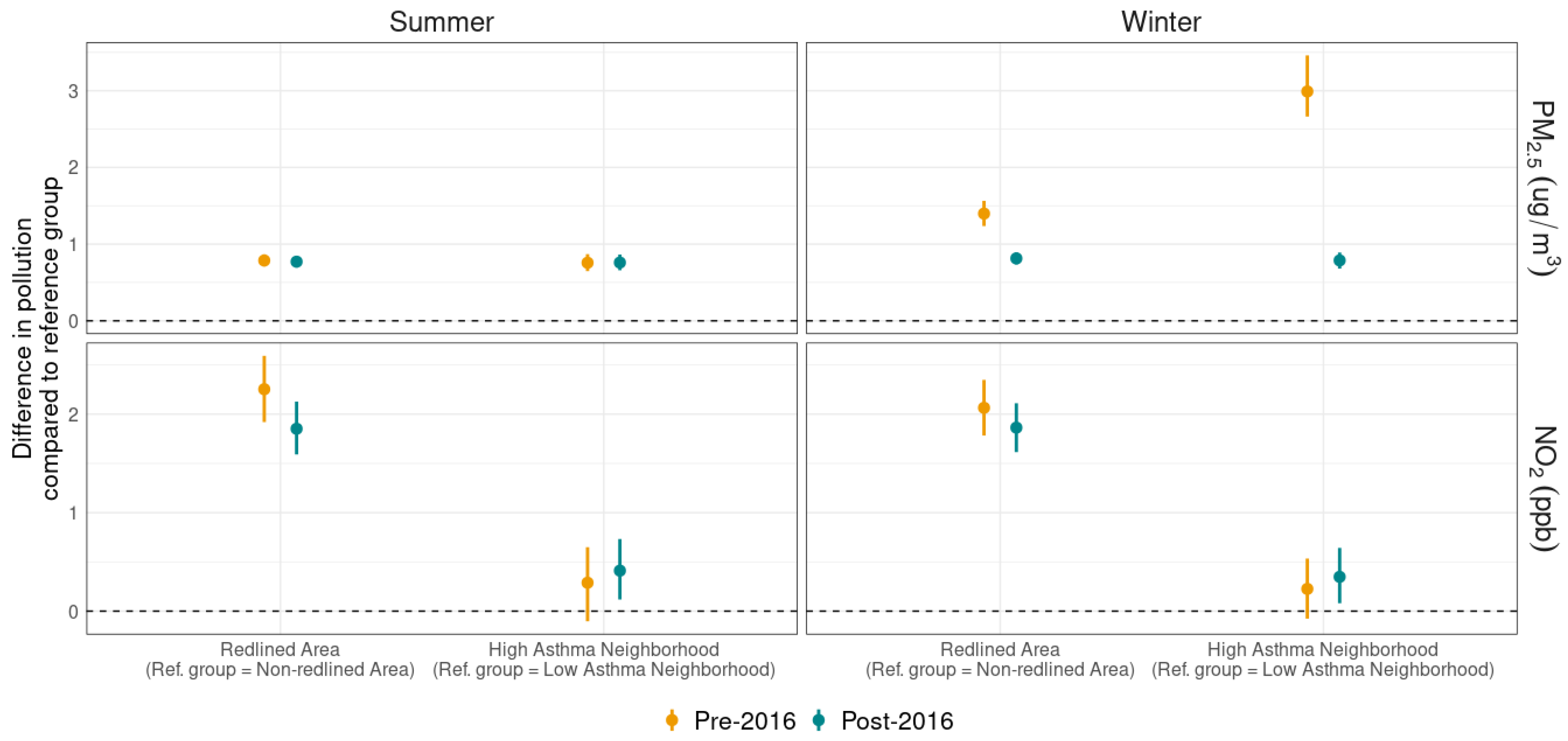
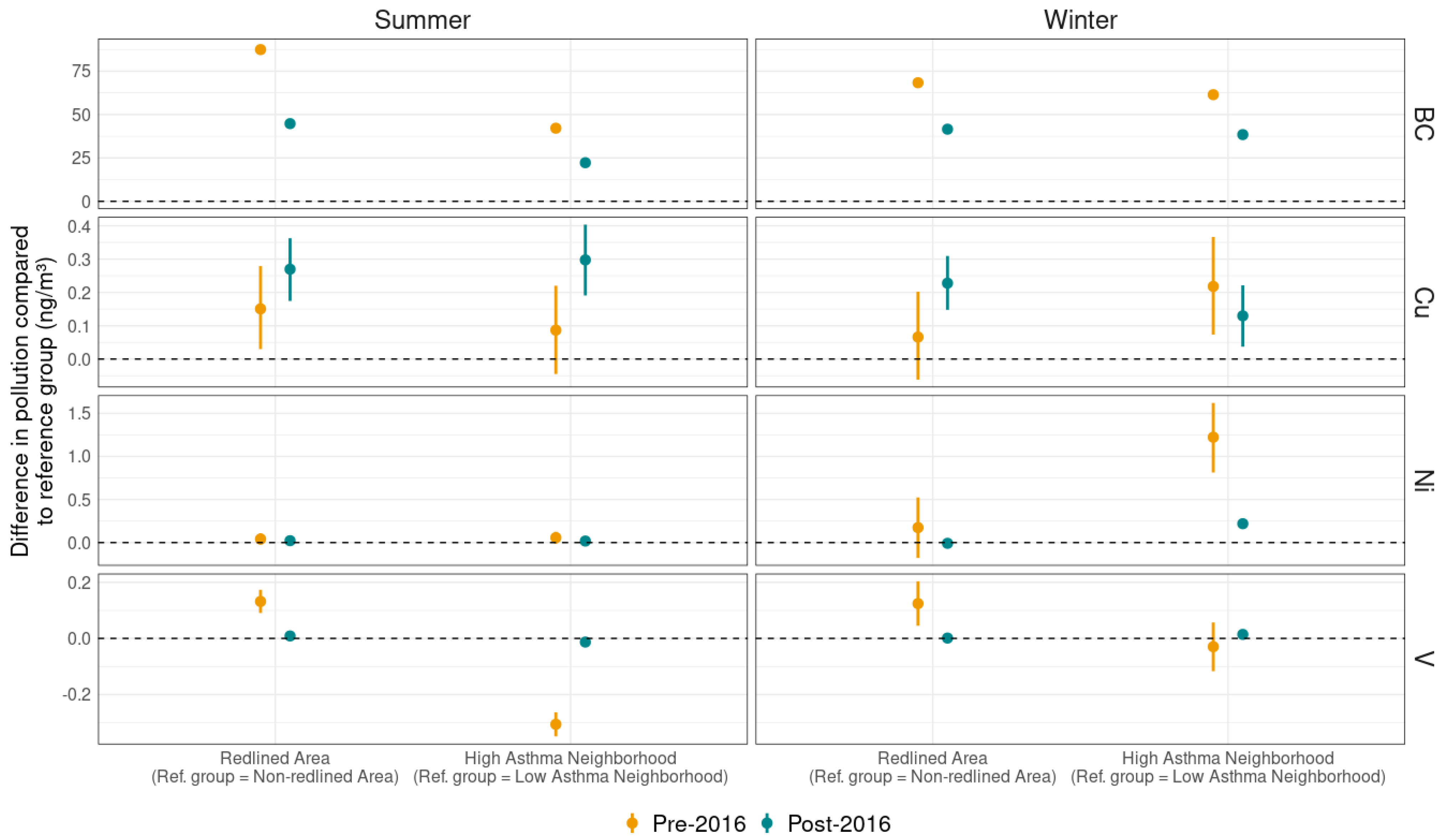
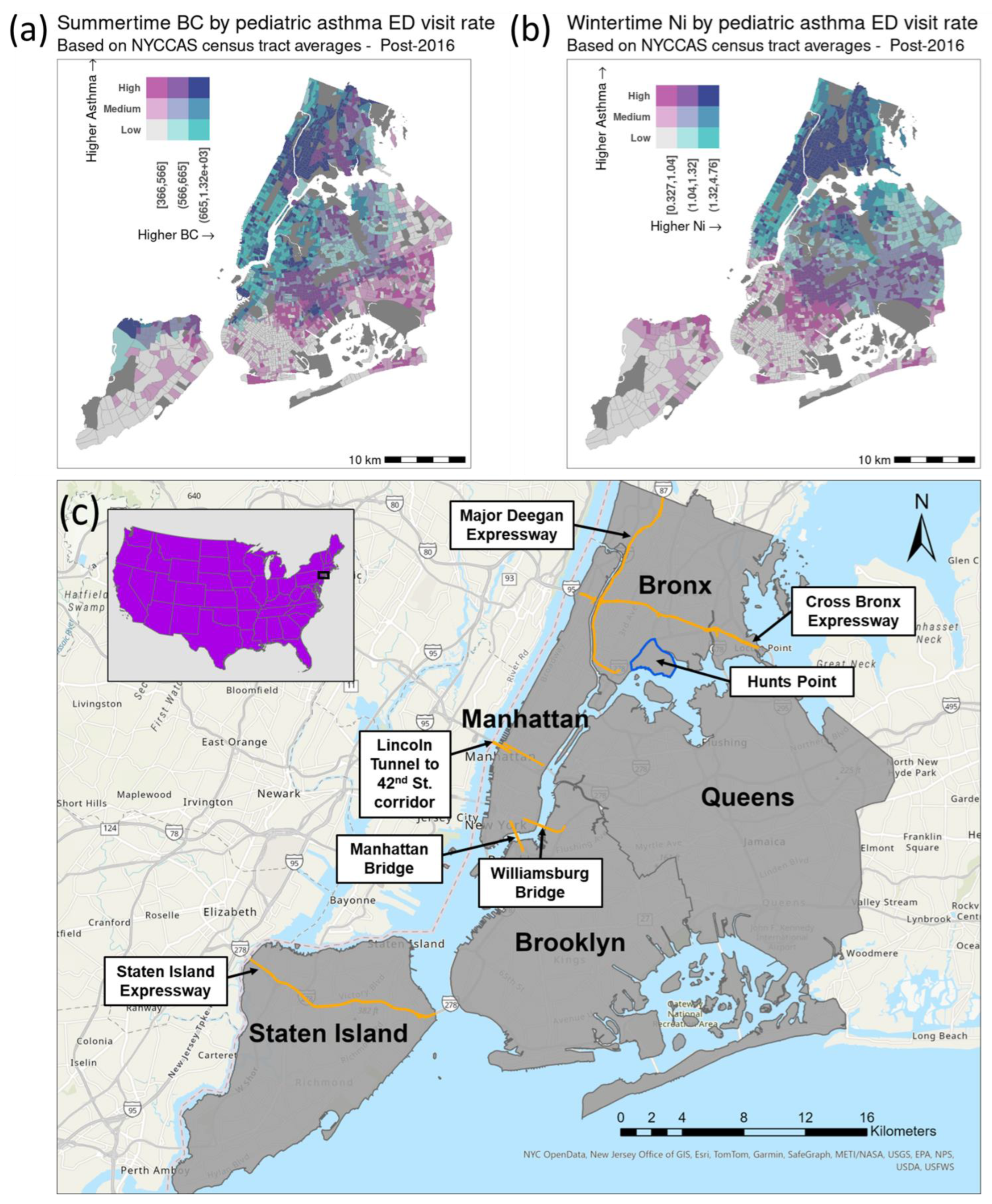
Disclaimer/Publisher’s Note: The statements, opinions and data contained in all publications are solely those of the individual author(s) and contributor(s) and not of MDPI and/or the editor(s). MDPI and/or the editor(s) disclaim responsibility for any injury to people or property resulting from any ideas, methods, instructions or products referred to in the content. |
© 2025 by the authors. Licensee MDPI, Basel, Switzerland. This article is an open access article distributed under the terms and conditions of the Creative Commons Attribution (CC BY) license (https://creativecommons.org/licenses/by/4.0/).
Share and Cite
Pitiranggon, M.; Johnson, S.; Spira-Cohen, A.; Eisl, H.; Ito, K. Determining Sources of Air Pollution Exposure Inequity in New York City Through Land-Use Regression Modeling of PM2.5 Constituents. Pollutants 2025, 5, 2. https://doi.org/10.3390/pollutants5010002
Pitiranggon M, Johnson S, Spira-Cohen A, Eisl H, Ito K. Determining Sources of Air Pollution Exposure Inequity in New York City Through Land-Use Regression Modeling of PM2.5 Constituents. Pollutants. 2025; 5(1):2. https://doi.org/10.3390/pollutants5010002
Chicago/Turabian StylePitiranggon, Masha, Sarah Johnson, Ariel Spira-Cohen, Holger Eisl, and Kazuhiko Ito. 2025. "Determining Sources of Air Pollution Exposure Inequity in New York City Through Land-Use Regression Modeling of PM2.5 Constituents" Pollutants 5, no. 1: 2. https://doi.org/10.3390/pollutants5010002
APA StylePitiranggon, M., Johnson, S., Spira-Cohen, A., Eisl, H., & Ito, K. (2025). Determining Sources of Air Pollution Exposure Inequity in New York City Through Land-Use Regression Modeling of PM2.5 Constituents. Pollutants, 5(1), 2. https://doi.org/10.3390/pollutants5010002





